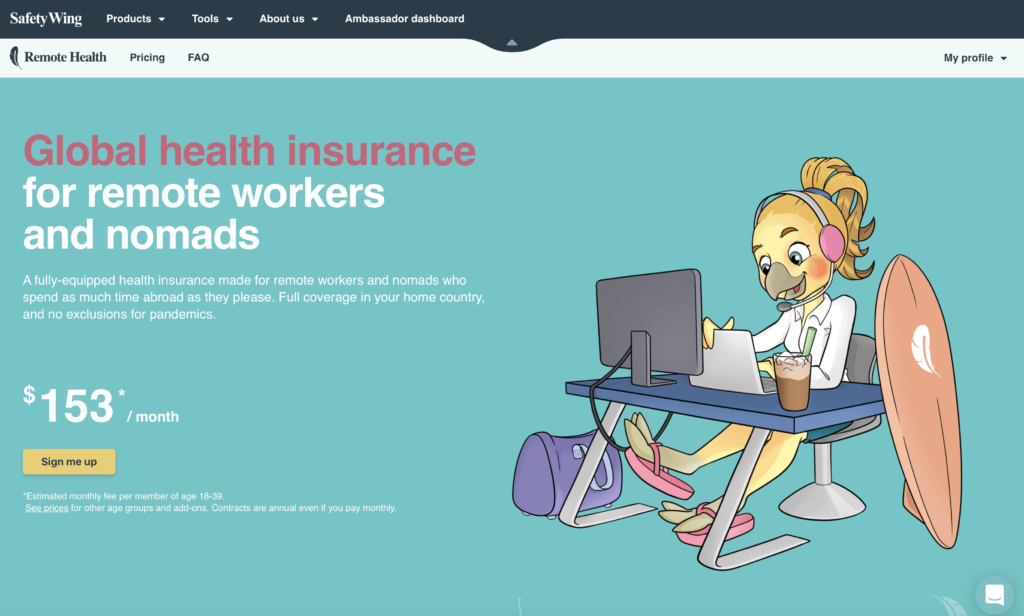
As the global workforce continues to shift towards remote work, one of the biggest challenges faced by digital nomads and freelancers is securing reliable health insurance. SafetyWing, a company known for its Nomad Insurance, has expanded its offerings with Remote Health, a comprehensive health insurance solution specifically tailored for remote workers, global teams, and those living or traveling internationally.
This review dives into the key features, coverage, and benefits of SafetyWing Remote Health, examining whether it’s the right fit for today’s location-independent professionals.
1. Overview of SafetyWing Remote Health
SafetyWing’s Remote Health insurance plan is designed to provide comprehensive global health coverage for individuals and companies with remote teams. Unlike traditional health insurance policies, which are often limited by geography, Remote Health offers worldwide coverage, ensuring that remote workers can access medical care regardless of where they are.
Key highlights of the plan:
- Global Coverage: Includes medical care in any country around the world, with the option to include or exclude the U.S. in coverage based on your needs.
- Customizable Plans: Available for both individuals and companies, allowing employers to offer health benefits to their globally distributed teams.
- No Exclusions for COVID-19: As the pandemic continues to impact global travel, SafetyWing provides coverage for COVID-19 treatment, making it relevant for current times.
2. What Does SafetyWing Remote Health Cover?
The scope of Remote Health is broad, covering most medical situations a remote worker might face, from routine checkups to emergencies. Here are the primary areas of coverage:
- Inpatient and Outpatient Care: This includes hospital stays, surgeries, specialist visits, and general medical consultations.
- Prescription Drugs: Medications prescribed by your doctor are covered under the policy.
- Preventive Care: Includes annual checkups, vaccinations, and screening tests.
- Mental Health Services: Remote Health covers mental health treatments, such as therapy sessions and psychiatric care.
- Emergency Medical Evacuation: If you need urgent medical care that isn’t available locally, the insurance covers transport to the nearest facility where treatment can be provided.
- Dental and Vision Care (Optional): These services can be added as a supplementary benefit for an additional cost.
3. Who Is Remote Health Best For?
SafetyWing Remote Health is designed with the remote worker and digital nomad in mind, but it’s also a great solution for startups and companies with employees scattered across different countries. Here’s who can benefit most:
- Freelancers and Digital Nomads: For those traveling between countries or living in various places for extended periods, this plan ensures you don’t lose access to health care while on the move.
- Remote Teams: Companies that employ workers in different countries can use Remote Health to offer a unified health insurance plan across all team members, regardless of where they live.
- Expatriates: Individuals who have relocated to a foreign country for work or personal reasons will find this plan fits their needs, particularly if they live in regions with underdeveloped healthcare systems.
4. Pros of SafetyWing Remote Health
Remote Health has several advantages that set it apart from traditional insurance plans:
- Global Coverage: One of the biggest selling points of SafetyWing is its worldwide reach. Whether you’re working from a beach in Bali or in a café in Paris, you’ll have access to medical care.
- Flexible Plans: Remote Health allows companies to offer coverage to a remote team spread across multiple countries, which is something most domestic insurance providers don’t cater to.
- Affordability: Compared to many local insurance plans, Remote Health offers competitive pricing, particularly for individuals who don’t require U.S. coverage.
- Comprehensive Coverage: From emergency care to mental health services, Remote Health provides a broad range of health services that many remote workers value.
- No Long-Term Contracts: You can cancel your plan at any time, making it adaptable for those with fluctuating work or travel schedules.
5. Cons of SafetyWing Remote Health
While Remote Health is a robust solution, there are some potential drawbacks to consider:
- Exclusions in the U.S. Plan: For those who opt for U.S. coverage, it comes at a higher premium. If you spend most of your time in the U.S., other local insurance options may be more cost-effective.
- Not Available Everywhere: While Remote Health is designed for global coverage, certain regions or countries may have restrictions on coverage. It’s essential to check the fine print for specific country exclusions.
- Out-of-Pocket Costs: Like many health insurance plans, Remote Health has deductibles and co-pays, meaning you may still need to cover some expenses out of pocket depending on the treatment or service.
6. Pricing and Plans
The cost of Remote Health depends on several factors, including your age, the level of coverage, and whether or not you need coverage in the United States. Here’s a breakdown of the pricing:
- For Individuals: Prices start at approximately $153 per month without U.S. coverage. If you need U.S. coverage, expect the cost to be higher, starting around $230 per month.
- For Companies: Pricing is customized based on the size of the company and the number of employees to be insured. However, it generally offers more flexibility and cost efficiency for teams compared to purchasing separate local policies for each employee.
7. How Does SafetyWing Compare to Other Providers?
When compared to other global health insurance providers like Cigna Global or GeoBlue, SafetyWing stands out for its affordability and flexibility. However, other providers may offer more extensive networks or specialized coverage for specific regions.
- Cigna Global: Offers more customizable options for expatriates and remote workers, but at a higher cost than SafetyWing.
- GeoBlue: Provides robust global coverage with a strong focus on U.S.-based care, which might be a better fit for those frequently traveling back and forth to the U.S.
Conclusion: Is SafetyWing Remote Health Right for You?
For remote workers, digital nomads, and global teams looking for flexible and comprehensive health coverage, SafetyWing Remote Health is a strong contender. Its global reach, affordability, and comprehensive coverage make it an excellent option for those who work across borders. However, if you spend a significant amount of time in the U.S. or need extensive regional coverage, it’s worth comparing other options to ensure you get the best plan for your needs.
Ultimately, SafetyWing Remote Health addresses a major gap in the health insurance market for the growing number of people working remotely from different parts of the world. Whether you’re a freelancer, part of a distributed team, or an expat, this plan provides peace of mind, ensuring that no matter where you are, your health is protected.






